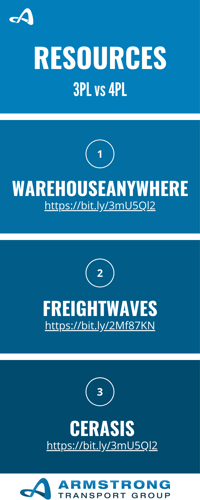By: Ben Eason on January 22nd, 2021
3PL vs 4PL: Which Model Best Suits Customer Demand?
Insider | Logistics | Transportation | Best Practices | Agent Program | Freight Management
Is your company’s supply chain getting more complex? Do you have the actionable information you need to respond to customer demand?
Transporting goods can involve a dizzying array of processes and data, which is why so many organizations outsource some or all of their logistics. Determining which outsourcing model – 3PL (third-party logistics providers) vs. 4PL (lead logistics providers) – works for your business can be essential to growth and cost-savings.This post will examine how 3PLs and 4PLs provide value to different organizations. How can a business be certain which model they need? Do the lines between 3PLs and 4PLs ever blur? And is there an evolutionary process by which a 3PL can or will eventually become a 4PL (and then a 5PL)?
Why Companies Outsource Logistics
For centuries, goods moved from one location to another using a relatively simple, linear process. A shipper would load a box or crate onto a cart or ship, which would deliver the item to its destination.
Absent of modern supply chain complexities, shippers owned and dictated the distribution of their goods. We refer to this model as 1PL or first-party logistics. Companies still use this model today – like a baker who delivers cookies to a coffee shop for sale.
Carriers providing a transport service – like a rail operator or a trucking company – are referred to as 2PLs or second-party logistics providers.
A Variety of Logistics Services Models
Beyond 1PL and 2PL, there are three additional models: 3PL, 4PL, and 5PL. Plenty of articles define each model and discuss the differences between each. We've included a few of our favorites in the Resource Corner on this page.
If you're still confused after doing some research, don't worry. It's not you. Really. The logistics landscape is hardly clear for anyone, and to make matters more confusing – it is always changing.
3PLs vs. 4PLs: How Business Growth Impacts Logistics Services
A Case for Third-Party Logistics
When businesses grow to a point where they can benefit from outsourcing all or much of their logistics operations, they will likely engage the services of a 3PL. As its name suggests, a 3PL serves as an intermediary accepting goods from a shipper and tendering the load to a carrier.
These days, any company that offers some type of logistics service for hire is considered a 3PL. Some 3PLs provide one or two services, while others offer many. Ideally, services are bundled and include transportation, warehousing, freight forwarding, cross-docking, inventory management, and packaging.
 Armstrong is a 3PL that currently specializes in transportation management. We also provide our customers with actionable, real-time information through our proprietary transportation management platform. Armstrong uses tools like Parade for digital freight matching, Transflo for tracking and tracing loads, and my CarrierPackets.com for onboarding carriers to help maximize efficiencies in the freight management process.
Armstrong is a 3PL that currently specializes in transportation management. We also provide our customers with actionable, real-time information through our proprietary transportation management platform. Armstrong uses tools like Parade for digital freight matching, Transflo for tracking and tracing loads, and my CarrierPackets.com for onboarding carriers to help maximize efficiencies in the freight management process.
WarehouseAnywhere is another example of a 3PL that provides warehousing and distribution services. Other companies might start out providing transportation management solutions, add warehousing, and ultimately offer a full array of logistics services. In many cases, shippers will use one 3PL for transportation, another 3PL for warehousing, and yet another for distribution.
Generally, small and midsize businesses benefit from 3PL services. This is because their companies' size and scope allow them to manage all 3PL relationships internally.
The Role of Lead Logistics Providers
Based on fluctuating consumer demand and our ability to innovate, many businesses grow. With that growth comes increased complexity. At a certain point, shippers recognize that managing their various 3PL relationships creates inefficiencies. Perhaps there is a greater need for one point-of-contact to oversee all logistics strategies and operations. The benefit of optimizations and integrations to the organization may outweigh trying to keep up with one-off transactions.
A 4PL manages the organization's supply chain operations, including carriers, warehouses, reverse logistics (i.e., returns and repairs), and more. This is why they are referred to as lead logistics providers. Their job is to break down silos created during rapid growth periods and provide more visibility and transparency across the organization. When done right, this leads to efficiencies and cost savings.
While this is not always the case, medium to large corporations can frequently benefit from 4PLs. Companies like UPS, XPO Logistics and Accenture offer full-scale supply chain management services.
Which Logistics Services Model to Choose?
 Neither the 3PL nor 4PL model is superior to the other. What works for one business might not work well for its direct competitor. For example, 3PLs might help a small to midsize business with fast-growing orders save time and money, but if demand fluctuates and orders slow, it could be quite costly for that business to retain their 3PL. A 4PL might create an optimized supply chain, but the company might find that relinquishing control over specific logistics processes can create hurdles internally.
Neither the 3PL nor 4PL model is superior to the other. What works for one business might not work well for its direct competitor. For example, 3PLs might help a small to midsize business with fast-growing orders save time and money, but if demand fluctuates and orders slow, it could be quite costly for that business to retain their 3PL. A 4PL might create an optimized supply chain, but the company might find that relinquishing control over specific logistics processes can create hurdles internally.
Technology is another consideration. Even in the logistics industry, where pen-and-paper processes reigned for hundreds of years, technology growth is rampant. As businesses consider the costs and benefits of outsourcing, they need to think about technology compatibility and integrations and the potential impact that changes might have on the organization's budget and processes.
Do 3PLs Eventually Evolve to Become 4PLs?
3PLs run their business in unique and varying ways. We me ntioned that some 3PLs offer one or two logistics services, while others offer various capabilities. There are those 3PLs that grow organically and those that make multiple acquisitions of other 3PLs to add to their overall services portfolio. According to this EasyShip blog post, some 3PLs form a 4PL organization within their existing structure.
ntioned that some 3PLs offer one or two logistics services, while others offer various capabilities. There are those 3PLs that grow organically and those that make multiple acquisitions of other 3PLs to add to their overall services portfolio. According to this EasyShip blog post, some 3PLs form a 4PL organization within their existing structure.
None of these changes happen overnight. Josh Nelson, Associate Principal at The Hackett Group, told Supply Chain Dive in this article: "What happens is, a company finds a 3PL to work with and receives good value while [the 3PL] expands into a 4PL. There's a lot of trust and transparency, so a client doesn't feel it's being taken advantage of. Because the 4PL performs well, it can expand the services of what it provides. Think of it as a sliding maturity scale—gaining trust and expanding services. Once a client gets used to a 4PL, they can't easily go back to 3PL."
Not all 3PLs will evolve to become 4PLs. Some industry watchers predict that 3PLs will focus more on industry segments and subsegments (like medical device supply chains within the broader healthcare industry), as noted in this Inbound Logistics article.
Want to Learn More?
Deciding which model to use is not easy, which is why we encourage you to reach out to experts for help. As a Top 25 Freight Brokerage, Armstrong Transport Group is growing too. We understand that your business is becoming increasingly complex, and customer expectations are rising.
Whether your shipping needs require 3PL services or you are considering a transition to a 4PL model, our team of logistics experts can help answer your questions. Connect with us today to learn more!


